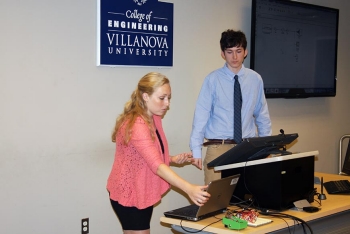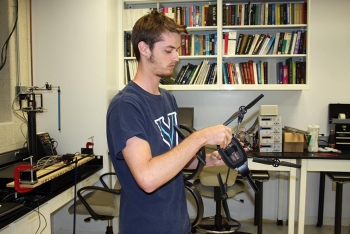Student Teams Present Engineering Innovations through a Campus-Based Incubator Experience
Thanks to a generous $75,000 grant from the Harris Foundation, four multidisciplinary teams of engineering students were competitively selected to participate in a new, campus-based incubator program called the Villanova Summer Innovation Incubator (VSII). The Harris Foundation is the philanthropic arm of the Harris Corporation, a leading provider of communications and information technology, led by Chairman, President and Chief Executive Officer William M. (Bill) Brown ’84 ME, ’87 MSME , a member of the Engineering Advisory Board. “VSII is a program that takes young student engineers and turns them into the problem solvers of the future,” says Brown.
VSII is emblematic of the College of Engineering’s ongoing commitment to transform the way engineers are taught. Through this program, self-directed student teams engaged in the design process to address “real world” challenges, mirroring the practice of professional engineers. Working in an open, highly collaborative environment, teams pursued innovative solutions to unmet societal or technological needs of their choosing. Outside of weekly update meetings with their respective faculty mentors, students were responsible for managing all aspects of their projects, from initial design concept through delivery of a prototype. During their two-month innovation residency, they received stipends, free room and board, project budgets and access to labs and facilities.
On July 31, 2015, the inaugural VSII teams presented their work to an audience of College students, faculty and staff. Also in attendance was Harris’s campus brand ambassador, Brittany Ransbottom, an electrical engineer with Harris RF Communications. Drosdick Endowed Dean Gary A. Gabriele welcomed the attendees and thanked the Harris Foundation for making the program possible.
The four VSII teams included:

John Lee ’17 ME and Sajid Hossain ’16 EE worked with UNICEF Burundi (Africa) on an open source solution for Solar and Cycle Chargers for Head Lights and Cellular Phones.
John Lee ’17 ME, Sajid Hossain ’16 EE, Sandy Campos ’16 EE and graduate student Saul Nunez who worked with UNICEF Burundi (Africa) on an open source solution for Solar and Cycle Chargers for Head Lights and Cellular Phones. Through this humanitarian design project, the team sought to provide an affordable and sustainable solution to charging portable lights and phones in one of the poorest regions in the world, with little to no access to electricity.
During their presentation, John acknowledged the importance of communication in a group project, while Sajid appreciated that his course work proved to be applicable to the work he was doing on the project. “I also developed an interest in sustainable engineering as a result of the experience,” he added.

Peter Houtkin ’16 EE and Elizabeth Tyhacz ’16 ME presented their digital guitar pedal to an audience including a representative from the Harris Foundation as well as students, faculty and staff.
Peter Houtkin, a senior Electrical Engineering and Mathematics dual major, and Elizabeth Tyhacz, a senior Mechanical Engineering student with minors in business and entrepreneurship, designed a Tone Mimicking Guitar Pedal that can reproduce the tone and effects of two distinct, distortion pedal boards. By applying multiple effects to an input signal simultaneously, this digital pedal is an inexpensive alternative to the use of various analog guitar pedals.
Elizabeth said the experience helped her realize the importance of an advisor/mentor, while Peter enjoyed “working on something I am passionate about without having to worry about being graded.”

Ryan McNulty ’16 CpE was part of the team working on “Collaborative Unmanned Vehicle-Aided Monitoring and Decision-Making.”
The third VSII team, made up of seniors Carly Danek ME, Ryan McNulty CpE and Peiyan Gong EE, worked on Collaborative Unmanned Vehicle-Aided Monitoring and Decision-Making, an emerging research area with many potential applications for both civilians and the military. Their goal was to have an overhead vehicle (drone) find an object on the ground, and with a host computer determine a safe path to reach that object. That information would be sent to a ground vehicle for retrieval. Throughout the process, all vehicles would move autonomously.
Carly learned a number of lessons in the process: “You have to be prepared to adapt your design and overall plan in response to unanticipated challenges. It was a great opportunity because there wasn’t necessarily a correct answer to the problem; you have the freedom to do anything you choose with your project.”

Nicholas Kambouroglos ’16 CpE, William Landis ’16 CpE, Molly McGuinness ’16 CLAS and Abbey Buckenheimer ’16 ME formed team HEMABYTE to develop a portable blood testing unit.
The final group to present was Team HEMABYTE. Nicholas Kambouroglos ’16 CpE, William Landis ’16 CpE, Molly McGuinness ’16 CLAS and Abbey Buckenheimer ’16 ME designed a low-cost, portable blood testing unit that can measure the Complete Blood Count (CBC), the most commonly ordered blood test.
William said, “The program gave us the opportunity to pursue an idea we were passionate about. The project had a real world learning curve in areas such as teamwork, budget management, prototyping and product development. It also provided the baseline potential of starting a business in the biotechnology industry.”
Dean Gabriele, who has made it his mission to provide students with one of the most innovative engineering education programs in the country, finds that VSII is a perfect example of what’s possible when you engage students in these types of experiences. “Even in the absence of formal classes and assignments, grades and credit, undergraduates can learn engineering by practicing engineering. They also can lead to truly novel innovations.” He adds, “We couldn’t offer these opportunities without the support of partners like Harris Corporation.”
